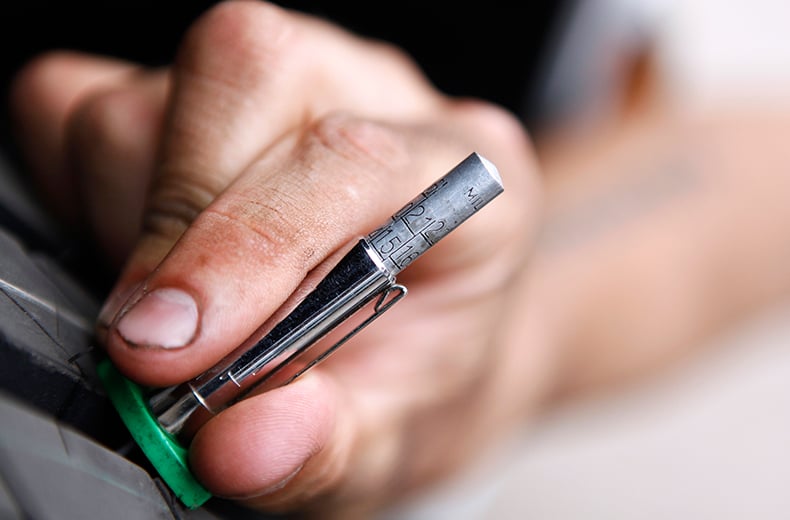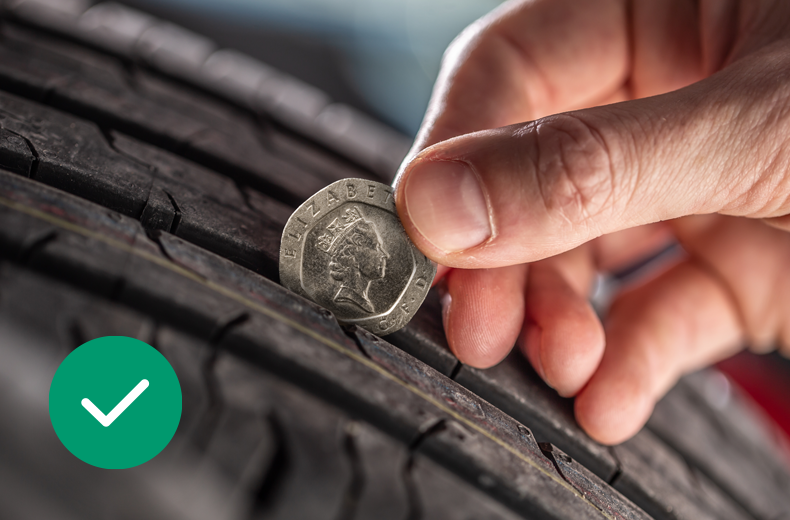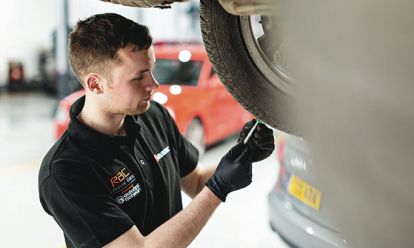The tyres are the only contact point between your vehicle and the road. If your tyres are past their best then the safety of your vehicle will be compromised.
Driving a car with bald tyres can risk a fine of £2,500 and three penalty points. That’s per tyre, too. If all four tyres are worn below the legal limit, you could potentially be summoned to court, lose your licence and face a £10,000 fine.
Read on to find out how to check your minimum tyre tread depth and ensure you stay safe and legal on the road.
What is the legal tyre tread depth limit in the UK?
The legal tyre tread depth limit for cars in the UK and Europe is 1.6mm across the central three-quarters of the tyre. By law, the tread depth must meet this minimum requirement across its complete circumference.
Bald tyres are one of the most common reasons for MOT fails, which is why it's essential that you get into the habit of checking your car's tyres regularly.
If you are not confident checking your car's tyres yourself, you can arrange for it to be checked by a mobile mechanic or local garage.
What is the minimum tyre tread depth?
Tyre and safety experts believe the 1.6mm legal minimum is insufficient to guarantee safety – most recommend a minimum tread depth of 3mm for tyre replacement.
Tests by UK technical organisation MIRA found that, once tyres are below 3mm, stopping distances increase dramatically.
The difference in wet braking distance between a tyre worn to 3mm and one worn to 1.6mm can be as much as 44%.
Worn tyres are particularly dangerous in the wet because a tyre’s tread helps disperse water away from the contact patch between tyre and road.
If there’s less tread depth, less water can be shifted, increasing the risk of aquaplaning and losing grip.
In heavy rain, each tyre can shift one gallon of water every second, illustrating just how hard tyres work.
Simply put, deeper tread means they can work better, improving grip.
How to check your car tyre tread depth
Tyre tread depth of your car must to be above 1.6mm to be safe and legal. The 1.6 minimum tyre tread depth must be the case for the middle three quarters of the tyre.
If you are unsure if the tyres on your car meet the legal minimum standard then there are three simple methods you can use to check the tread depth:
- Perform the 20p test
- Inspect the wear indicators on the tyre (if fitted)
- Check the tyre tread with a depth gauge
How to check tyre tread depth – the 20p test

The 20p test is a simple, quick and easy way of checking the tyre tread of your car's wheels.
Just take a 20p coin and insert it into the tread grooves on the tyre.
If you can't see the outer band on the coin, your tyres are above the legal limit.
However, if you can see the band and that section of the coin is still visible, your tyres could be unsafe and require professional inspection by a mechanic.
We suggest drivers conduct the 20p test around every two weeks and before long journeys.
Checking tyre tread with tyre tread wear indicators
Some tyres will have indicators embossed on the tyre wall itself, usually with a line or arrow which is positioned somewhere below the outer tread.
If the tyre is flush with these markers then the tread may be at or below the 1.6mm legal limit and will need replacing.
Checking tyre tread with a tyre tread depth gauge

A tyre tread depth gauge is a purpose made tool that makes it easy to quickly measure the depth of an individual tyre groove. Simply place the tool on the tyre and it will tell you what the depth of your tyre is in millimetres.
Analogue tyre tread depth gauges (pictured above) are common, but digital gauges are also popular. Both tools make it easy to check your tyres are safe and legal.
READ MORE: How to check your car's tyre pressure
What happens if you have an accident on illegal/bald tyres?
Driving with tyres that have a tread below the legal limit - or even worse, are bald - is dangerous.
It can put you and other motorists at risk.
If you are involved in an accident and the car you are driving has illegal or bald tyres, you should be aware of the consequences.
Any insurance claim as a result of an accident could be invalidated, so potentially your insurer won't pay out any money any repairs needed to your vehicle.
However, driving with dangerous or defective tyres also puts drivers at risk of a fine of up to £2,500 and three points on their license.
That is per tyre, so four illegal tyres could mean a fine of £10,000 and 12 penalty points.
You can buy tyre tread gauges that help you assess the tread depth of the tyre, plus you can also get more basic colour-coded tools that let you know if a tyre is legal or not at a glance.
For more information about tyres read our complete guide to tyre buying or our complete guide to tyre safety and maintenance.
For complete piece of mind, you can also check out our breakdown cover and European breakdown cover products today.
ALSO: Learner driver insurance - from 2 hours to 5 months
If your tyre tread is below or neat the legal limit, we would recommend that you purchase a replacement tyre. Head over to RAC Tyres where we sell everything from budget to premium brands.

Roadside & Recovery from £5.29 a month*
• Cheaper than AA Price Guarantee^
• We get to most breakdowns in 60 mins or less
• Our patrols fix 4/5 breakdowns on the spot

Tyre tread depth and safety - FAQ
- Is 2 mm tyre tread legal?
Tyre tread depth has to be above 1.6mm to be legal. This must be the case for the middle three quarters of the tyre.
- What is the legal limit for tyres to pass MOT?
The legal tyre tread depth in the UK is above 1.6mm in the middle three quarters of the tyre.
- How long does the average tyre last?
In terms of miles a tyre should last, there is a general acceptance with manufacturers, that tyres have a lifespan between 20,000 and 40,000 miles. However. this can vary if you tend to drive on more uneven and challenging surfaces. Even if you drive limited miles each year, tyres should be replaced every five or six years. Always ask your mechanic at your annual MOT about the safety of your tyres. It is important to remember that for the majority of vehicles, the front tyres wear quicker than the rear ones.
- What depth should tyres be?
Tyre and safety experts believe the 1.6mm legal minimum is insufficient to guarantee safety – most recommend a minimum tread depth of 3mm for tyre replacement.
- What is the lowest legal limit for tyre tread?
The lowest trade depth for tyres is 1.6mm - which is a legal minimum. Industry experts recommend a minimum tread depth of 3mm for tyres.
- How long does it take for tyre tread to wear down?
Tyres wear down different depending on the road conditions and how often you use your vehicle. Manufacturers generally agree that they should be replaced every 20,000 to 40,000 miles. Your tyres should be checked every year during your vehicle’s MOT.
- What does 1.6 mm tread look like?
The 20p test is a simple, quick and easy way of checking the tyre tread of your car’s wheels. Just take a 20p coin and insert it into the tread grooves on the tyre. If you can’t see the outer band on the coin, your tyres are above the legal limit.

















